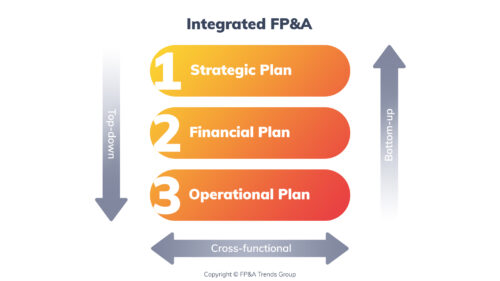
La FP&A et la maîtrise des données : un modèle d’excellence
Écrit par Larysa Melnychuk, fondatrice et PDG de FP&A Trends Group La planification et l’analyse…

This article was co-written by Larysa Melnychuk, Founder and CEO at FP&A Trends Group, and Olga Rudakova, International FP&A Board Ambassador and Data Visualization Trainer.
FP&A has witnessed a significant transformation in recent years, driven by a growing need for more holistic approaches. This shift has sparked an interest in ‘integrated FP&A’. Initially, the spotlight was on planning and forecasting processes. However, the focus has since shifted towards deep analytical insights, underlying business drivers, and data-informed decisions.
Yet, one might ask – can we truly achieve predictive and prescriptive analytics without first ensuring the synchronization of planning, forecasting, and analytics across the organization? In other words, is the path to analytical excellence feasible without embracing the principles of integrated FP&A?
When an organization achieves an ideal state of analytical excellence, it harnesses the full potential of its data, transforming raw numbers into actionable insights.
For instance, through the lens of analytical excellence, a retail company could accurately forecast consumer demand shifts to optimize inventory levels and reduce waste. Marketing strategies can become more targeted and effective as organizations can focus on desired customer segments and predict marketing campaign impacts.
Analytical excellence is not just about understanding the business and its key drivers. We’re talking about ensuring the entire organization moves in synchronization, like the precision gears in an analog watch.
In other words, we are aiming for integrated FP&A, or extended planning and analysis (xP&A) as some may know it. The International FP&A Board developed this concept through hundreds of meetings around the globe and many pieces of research.
The definition agreed by the FP&A Trends Group is:
“Integrated FP&A is a single and continuous framework where plans and forecasts are horizontally and vertically integrated. [Figure 1] This concept represents the coordinated departmental activities that lead to developing, assessing, and implementing ”the most likely scenarios” to achieve corporate goals. Also, it allows businesses to evaluate and support the impact of multiple futures on demand.”1

Figure 1
Despite the potential benefits of integrated FP&A, progress in its adoption remains notably slow. The FP&A Trends Survey 20232 indicated that only 29% of teams had either fully implemented the system or were beginning to explore the concept of Extended Planning and Analysis (xP&A). An additional 13% indicated they were contemplating it.
Additionally, Excel is still a predominant tool used by 52% of respondents and has only shown an 8% decrease since 2022 while the adoption of modern planning platforms rises slowly. In other words, there’s still a significant journey ahead for the full adoption of integrated FP&A methodologies.
The International FP&A Board has identified six key elements that are essential for a successful transition to Integrated FP&A based on insights and research gleaned from discussions with leading organizations.
It is important to identify and work closely with the most crucial business drivers. Businesses should prioritize the 20% of drivers that account for 80% of the results, as suggested by the Pareto Principle.
For example, an e-commerce retailer may focus on optimizing its website conversion rate, which directly influences revenue. By analyzing customer behavior data and website interactions, the company can identify the most impactful elements, such as page load speed or checkout process efficiency, which might account for 80% of the potential conversion improvements.
A simple driver-based model, even without the added sophistication of machine learning, can often outperform analytics, as well as forecasts that are merely based on last year’s actuals.
For example, an Ecommerce retailer can use a driver-based model that forecasts revenue through the number of active customers, the rate of new registrations, and the current industry growth trends rather than simply the previous year’s revenue.
A robust financial model ought to be a ‘three-way model,’ which seamlessly integrates the three core financial statements:
While this may seem straightforward, our experience indicates that only around 20% of organizations implement such interconnected models effectively.
Design a process that integrates strategic, financial, and operational levels of decision-making and allows smooth cooperation across the organization.
For example, a retail corporation can set up weekly cross-functional meetings for open communication and swift adaptation to market changes, ensuring that operational practices are aligned with financial goals.
Foster a structural and cultural shift within the organization. This involves understanding business drivers and encouraging collaboration across all functions.
For example, creating a centralized analytics hub in a manufacturing company can encourage analysts and business unit leaders to co-develop performance metrics and share insights during regular meetings.
The transition from isolated planning and analytical systems to a unified, integrated platform approach.
For example, a retail chain in which store managers operate independently in terms of inventory control and sales forecasting can implement a centralized data analytics platform that tracks sales, inventory, and customer preferences across all stores.
An American dining chain with over 200 restaurants has pioneered the use of an integrated financial planning system by a leading software vendor.
The restaurant business above refined its sales forecasting by leveraging detailed analytics on guest counts, average checks, and shift-specific sales data. This allowed for a nuanced annual trend analysis that provided a solid foundation for future business planning.
In the area of labor planning, the software offered restaurant managers weekly labor templates that were directly influenced by the sales forecasts. This ensured labor planning and costs were in lockstep with sales volume.
The driver-based models employed imported product ingredient data from third-party platforms and, therefore, enabled the company to create accurate projections of ingredients needed and ensure the availability of menu items.
Additionally, the platform facilitated financial planning with versatile reporting and analytical tools at a restaurant level.
This case shows how this dining chain aligned its strategy with financial planning and operational activities through an integrated financial planning system.
Businesses must act now to remain competitive and agile in a fast-moving world. The journey towards integrated FP&A needs to begin without delay to ensure that companies are setting the pace rather than simply keeping pace in their respective industries.
If you are unsure where to start your journey, the FP&A Trends Maturity Model can be a perfect first step. This tool allows organizations of any size, industry, and geography to identify the stage of their FP&A maturity compared to a leading-stage organization. It also allows them to create their transformation journey to improve their FP&A operations.
Sources